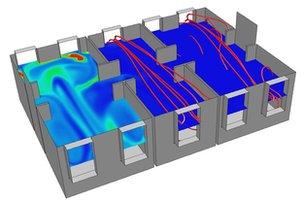Closing hospital windows 'increases infection risk'
Keeping the windows open on traditional NHS wards can dramatically reduce the risk of infection, say researchers.
The University of Leeds study suggests closing windows, for example to cut heating bills, increases the risk of infection fourfold.
The researchers used experiments and computer modelling to map the passage of air and germs through wards.
They say fitting household extractor fans to windows could maintain sufficient air flow in winter.
The study looked at air flow in traditional "Nightingale wards", built as open wards of around 30 beds with opening windows and named after Florence Nightingale, who set out the principles of ward design in the 19th Century.
Balloons filled with carbon dioxide - to represent an airborne pathogen - were popped and the gas followed throughout the ward using tracer devices.
Smoke sticks were also used to visually track the passage of air and wind streams.
The results showed that while the modern trend to partition wards to increase patient privacy changed the air-flow dynamics within a ward, good ventilation could be maintained if windows remained open.
"One of the biggest problems we have in the UK at the moment is that we don't have the money to just knock down every hospital and rebuild it," said Dr Cath Noakes, who led the study.
"We have to deal with what we've got, and many of the wards we've got are going to remain in use for a number of years to come.
"Our research was looking at these big naturally ventilated spaces to see what the risk of infection might be in there.
"What we found was that when the windows are open, these wards are very good.
"But if you close the windows and don't provide any alternative ventilation, the risks go up and they go up about fourfold.
"People are being told to seal up their buildings to save energy.
"We found, if you do that without alternative ventilation systems, you could be increasing the airborne infection risk significantly."
The researchers also looked at what could be done to maintain ventilation in winter months, when the windows had to be shut to keep patients warm.
"We actually used the little extractor fans - the type of thing you get in your bathroom at home.
"We installed those into the window and when we ran those, we found the risks became comparable to a naturally ventilated system."
Co-author Dr Miller Camargo-Valero said: "These simple, low-energy and low-cost solutions could also be of significant benefit for hospitals in the developing world, particularly in countries where airborne diseases such as tuberculosis are a major concern."
Funded by the Engineering and Physical Sciences Research Council, the studywas published in the Building and Environment Journal.
Hermetic seals
While the research could help inform practices in older NHS buildings, many newer UK hospital buildings feature no opening windows and complex computer-controlled ventilation systems.
David Docherty, head of estates at the Royal London Hospital, part of Barts Health NHS Trust, told the BBC there were other considerations when it was decided to move the hospital from its old Whitechapel premises to a new adjacent building - namely, air pollution.
"Obviously, the air quality of London meant that we had to consider our patients first and we have to consider the quality of the air that's coming to them," he said.
Instead of opening windows, the new Royal London Hospital has 200 units that bring clean filtered air into the hospital's 3,500 rooms.


No comments:
Post a Comment